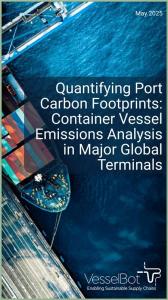
Major Global Ports Face Rising Emissions Despite Sustainability Efforts, VesselBot Study Reveals
This comprehensive port emissions report reveals unexpected drivers of maritime carbon footprint across Europe, North America, and Asia.
ATHENS, GREECE, May 22, 2025 /EINPresswire.com/ -- A comprehensive new study by Scope3 emissions tracking and optimization technology leader VesselBot, reveals that greenhouse gas (GHG) emissions at major global ports continue to rise despite technological advancements and sustainability investments. The report, "Quantifying Port Carbon Footprints: Container Vessel Emissions Analysis in Major Global Terminals," provides unprecedented insights into the environmental impact of container shipping operations at strategic global ports across Europe, North America, and Asia.
Key findings reveal:
• Shanghai port recorded the highest emissions (140,000 tons), surpassing Singapore despite handling fewer vessels, highlighting that vessel numbers don't directly correlate with emission levels
• Port congestion and inefficient operations significantly impact emissions, with U.S. ports reporting the highest congestion levels, particularly in January and February 2025
• U.S. ports experienced record-high container volumes and associated emissions in January and February 2025, driven by preemptive shipping ahead of new tariff implementations
• Singapore's investment in Digital Twin technology demonstrates how technological innovation can mitigate emissions despite high traffic volumes
"This report reveals the complex relationship between port activity and emissions," said Constantine Komodromos, CEO and Founder of VesselBot. "Our data shows that while more vessels generally mean more emissions, performance and operational efficiency are crucial mitigating factors."
The analysis utilizes VesselBot's primary data collection, which includes vessel geospatial data, operational characteristics, and cargo volume metrics, to calculate container vessel GHG emissions with unprecedented precision. The study quantifies how port shape, terminal availability, vessel dwell times, and engine utilization during idle periods significantly influence emission levels beyond simple vessel counts.
The report comes at a critical time as the maritime industry faces increasing pressure to reconcile operational demands with environmental responsibilities under tightening global emissions regulations.
The complete analysis is available here.
Maria Bena
VesselBot
+30 21 1117 8743
email us here
Distribution channels: Automotive Industry, Business & Economy, Consumer Goods, Food & Beverage Industry, Shipping, Storage & Logistics
Legal Disclaimer:
EIN Presswire provides this news content "as is" without warranty of any kind. We do not accept any responsibility or liability for the accuracy, content, images, videos, licenses, completeness, legality, or reliability of the information contained in this article. If you have any complaints or copyright issues related to this article, kindly contact the author above.
Submit your press release

